THICK vs. THIN GUM (Gingival Biotype, Gingival Phenotype).
These terms refer to the thickness of the gum. It does not refer to a healthy vs. non-healthy gum, but it only describes what type of gingiva (gum) Mother Nature has given us.
Having said that it is important to realize how the thickness of gums can impact our oral health, teeth or dental implants.
A simple way to define it, THIN gum is bad and THICK is good. Simply because Thin tissue can be stretched causing recession around teeth and dental implants, while a THICK gum is firm, bound to the underlying bone and protects teeth and dental implants.
Your content goes here. Edit or remove this text inline or in the module Content settings. You can also style every aspect of this content in the module Design settings and even apply custom CSS to this text in the module Advanced settings.
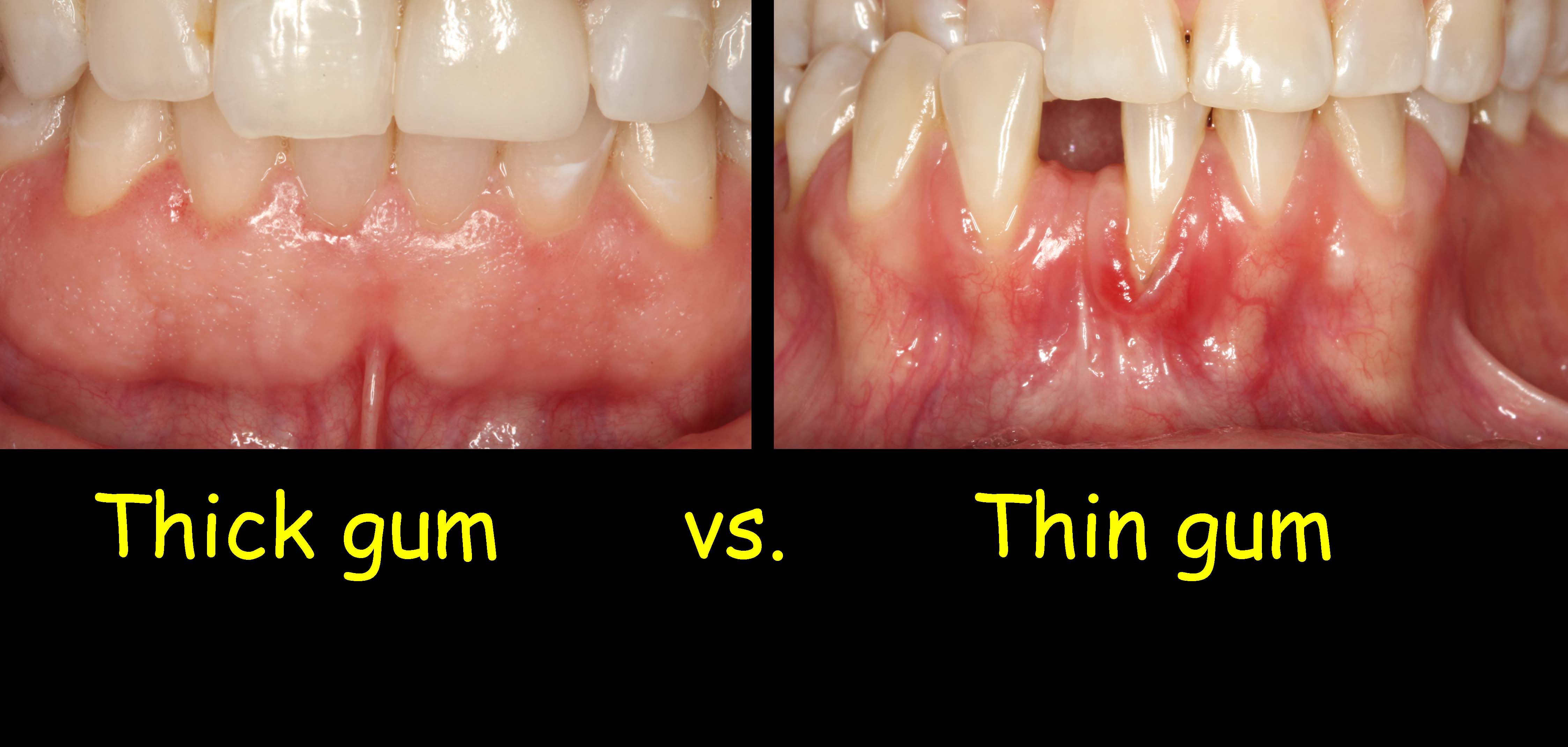
Most people with Thin gum, are at high risk to get gum recession. 78% of sites with untreated gum recessions, even with good oral hygiene will get worse through time. Gum recession is not related to how good your oral hygiene is. The thinner the gum the easier it gets traumatized while brushing or eating and then it recedes. In certain cases, the damage is permanent and repair to ideal is impossible. (Photo above compares the gums of a 52 year old on the R side vs. the gums of a 24 year old on the L side.)
Even during smiling, eating and talking the facial muscles will stretch the gum causing recession, something that you might not even be aware of. Roots are not covered with enamel and hence they are softer. When the roots are exposed, they wear much faster during normal daily brushing. This makes you get cavities easier on exposed softer root surfaces, when compared to hard enamel covering the crown.
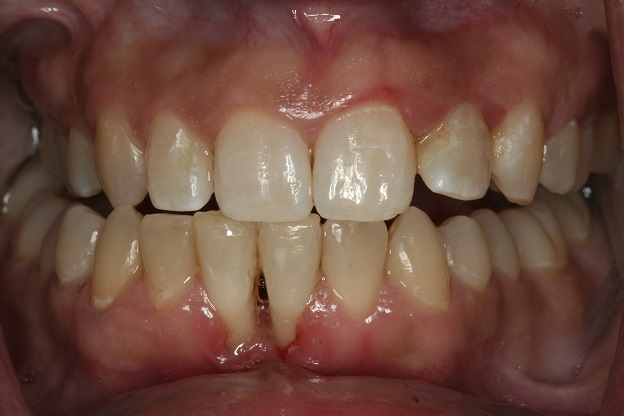
When you’re getting things like crowns, veneers, or fillings, or even surgeries like placing a dental implant or periodontal surgery, how thick your gums are matters a lot for healing and the results over time.
Thicker gums are like a shield—they resist irritation better and stay healthier in the long run.
What can be done if one has THIN gums.
Gums can be grafted to change its appearance. Different sources for Gum Grafts are from patients own mouth (usually palate) or from a tissue bank (cadaver). For those who do not like the idea of taking tissue from their palate, Cadaver soft tissue is a better option since it eliminates the donor site on the palate.
Gum Graft can be used to cover an exposed part of the root, instead of using white filling or bondings (Bondings needs to be replaced frequently, depending how well it is done in the first place)
Gum Graft used to covered the exposed and discolored part of the tooth (Canine/ single site)
The case presented below is an example of a single site root coverage.
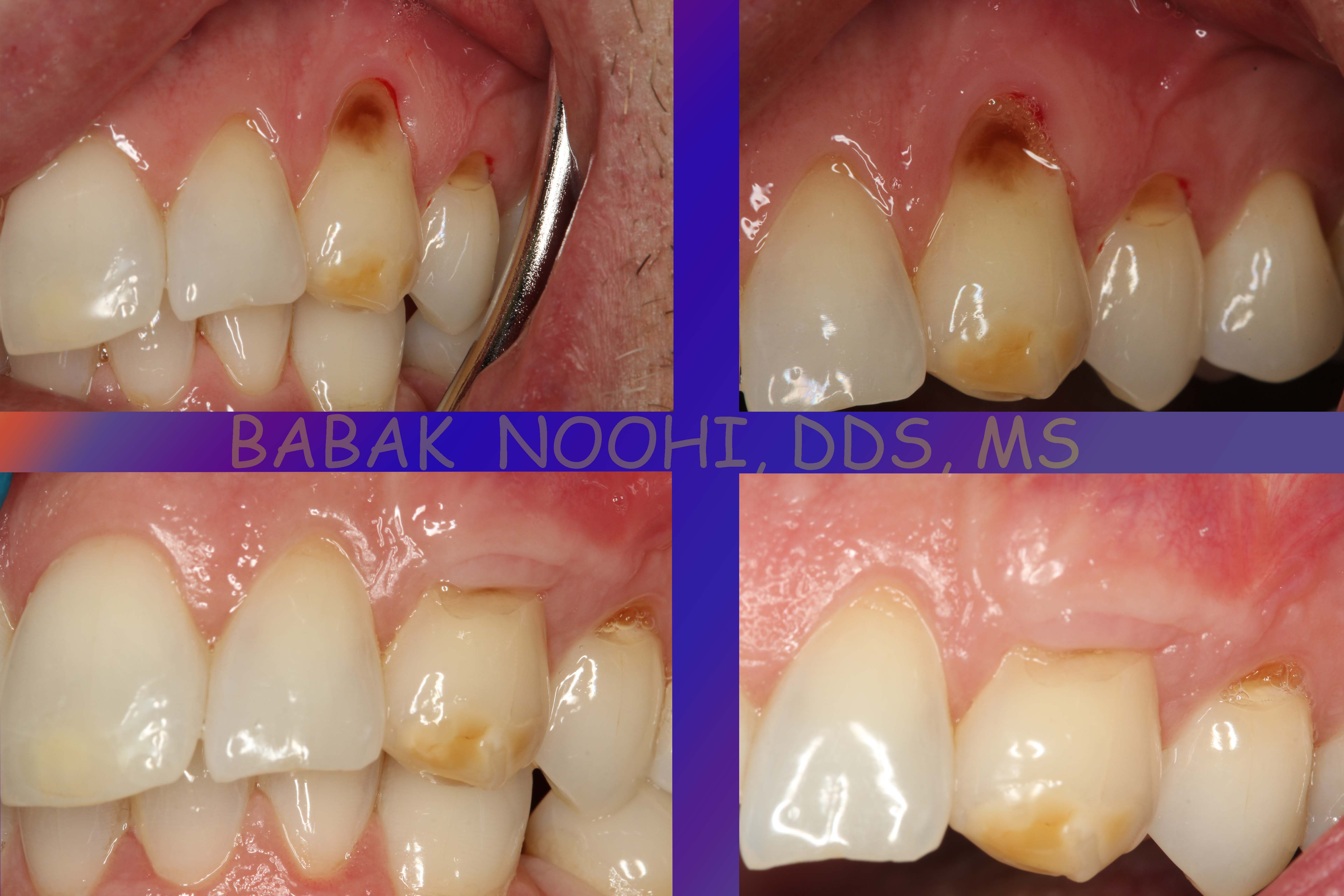
Gum Grafts can also be done for multiple teeth in a single visit to build up thick tissue and cover exposed roots.
By thickening the gums the risk of recession is minimized, saving you several fillings, teeth sensitivity, cavities, etc. in the future.
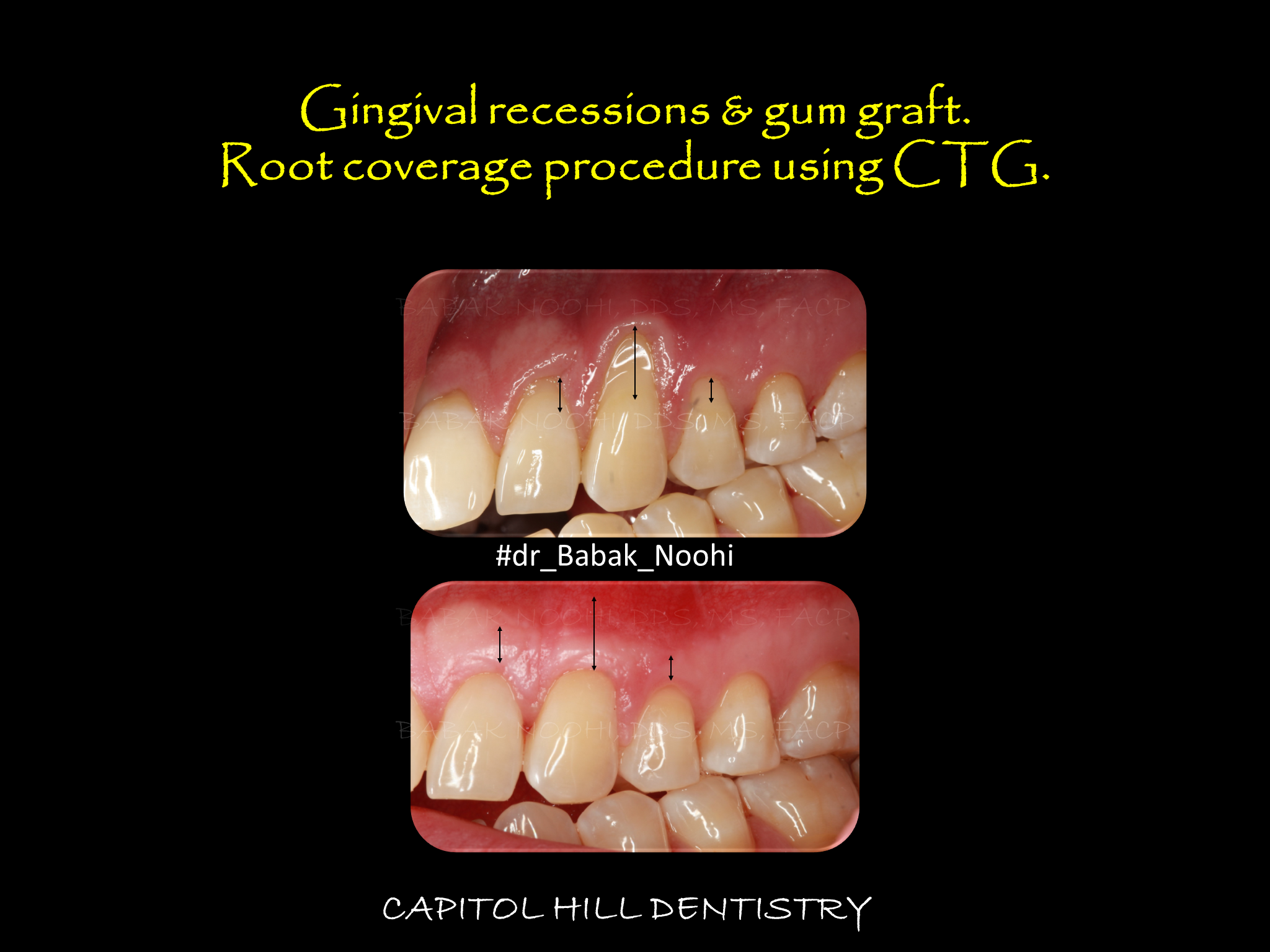
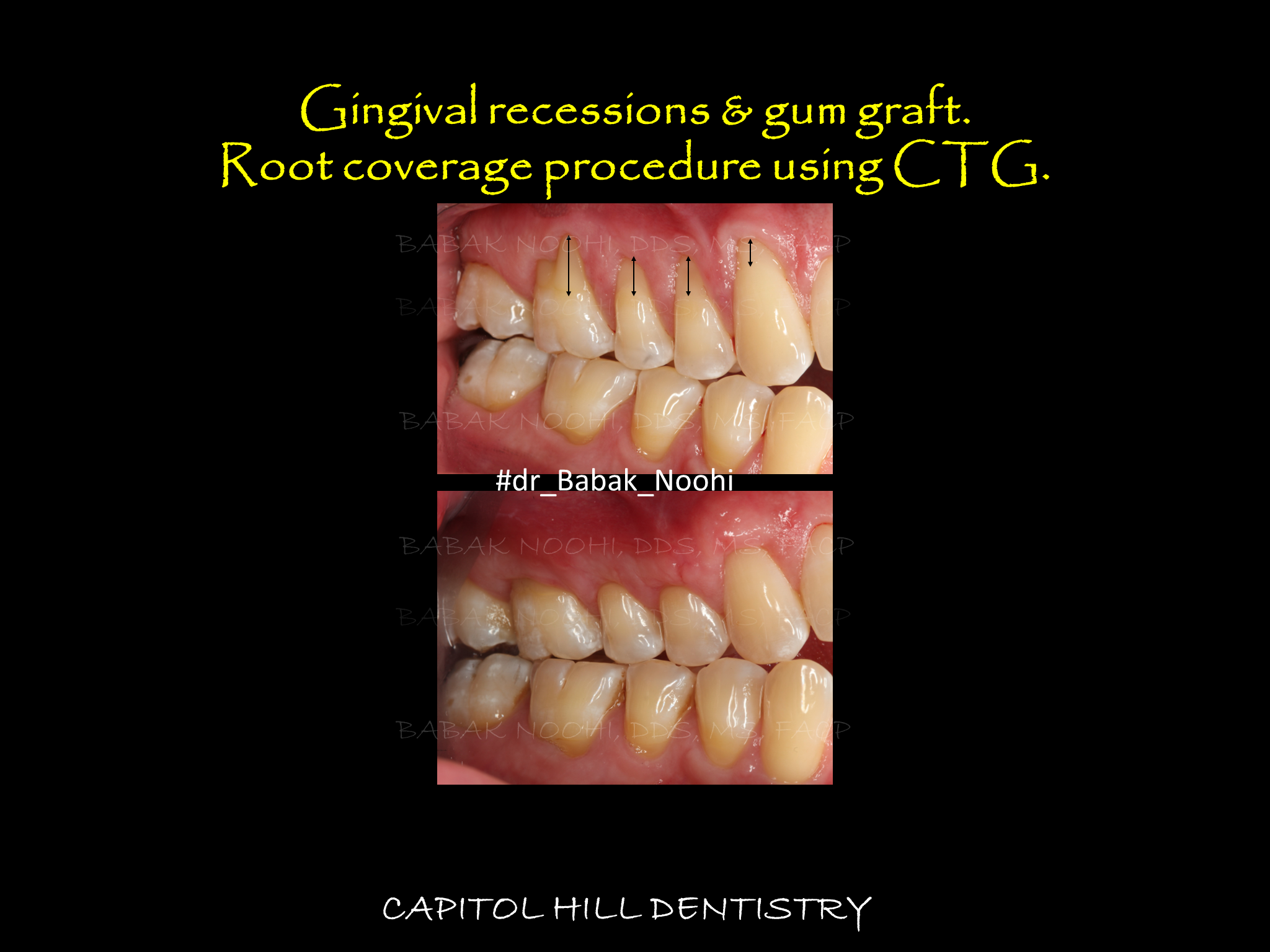
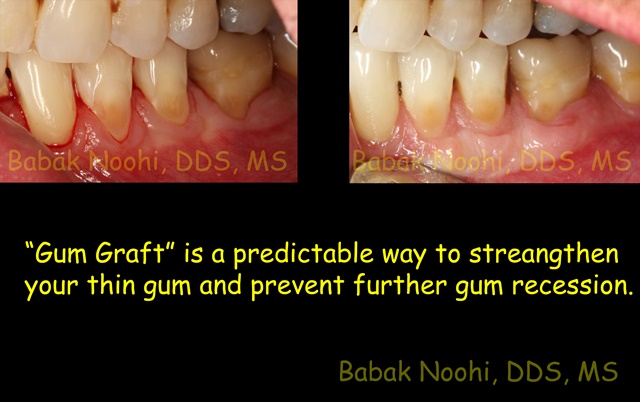
There are times gum recession happens despite the fact that there is a relatively thick gum. These are instances that other anatomical factors adversely influence the health of the gum. Below is an example.
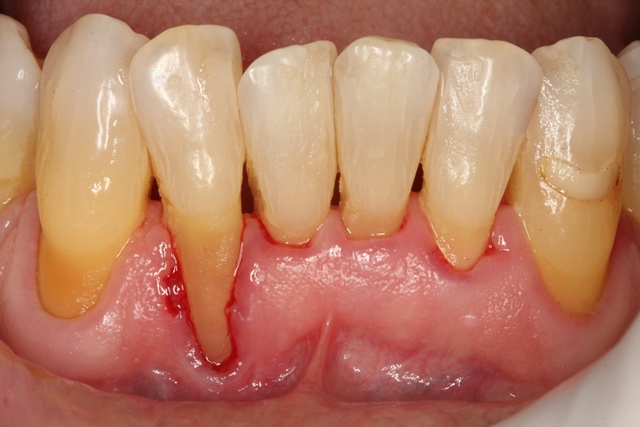
This single site recession can reasonably be improved with Gum Graft. The sooner you treat the site the more predictable the root coverage will be.
Gum Grafts before orthodontic treatment in people with thin gums is a common practice and will help your teeth stay healthy and beautiful. Gum Grafts can also be used to PREVENT further recession. It is not uncommon to perform gum (gingival) graft before orthodontic treatment, because teeth movement accelerate recession.
If you’re planning on getting braces or Invisalign, it’s crucial to have your gums checked first. This ensures you won’t make the condition of your gums worse and helps keep your oral health in check.
Dear Dr. Noohi. I had Alloderm grafting done over one year ago and root coverage was not achieved like I had expected. I am especially concerned about a couple of areas where the root is still exposed. Can KT be added even if the skin is thin? My periodontist tells me it is not necessary because the tissue is thicker and stable but each time I have my teeth cleaned my dentist and hygienist express concern. Thank you.
Dear Kristen
Thank you for your interest in my website and looking into it. You are asking a great question and my simple answer Yes. I have not seen you and i really don’t know your case well, so whatever i tell you is hypothetical, i want you to understand.
What your periodontist had told you, is correct. when Alloderm is used, you can expect a thicker tissue, even though on the surface you do not see any keratinized tissue. Some dentist challenge that argument, i shall say. So clinical presentation does matter and not all cases are the same.
I have a few cases documented where Alloderm had been used and it was a complete failure. That does not mean Alloderm graft is not a successful procedure, the skills of the dentist who is doing it also matters quite a bit. most of my failed cases were done by Periodontists.
there is a classification of gingival defect, which i cannot explain to you here, but where there is not keratinized tissue and there is recessions, my choice is always, Free Gingival Graft or Connective Graft. both of which are harvested from palate. Even though they are extremely successful procedures, telling patients i am going to take it from your palate may be scary. But i always give my patients a “palatal guard” to cover the wound, so it is not sore and they rarely have discomfort beyond 3-4 days.
i have used Alloderm for multiple sites, but i always carefully pick and select cases, because i don’t want to have failures.
If i use gum graft from palate i give my patients 100% guarantee that it will be successful.
I hope i could answer your question.
Thank you again for your interest.
I hade got my braces 2 months back and after this I’ve noticed myself clinching my teeth in sleep. Recently I noticed that I could see me teeth through my gum. So ,is clenching causing this to happen. If so how could I prevent it.
It is best to exam you clinically and in person. But to be short to answer your question
1- Clenching in your particular case, is most likely as a result of your orthodontic treatment and teeth movement. However, you could also have had para-functional habit (clencing, grinding, etc) in the past and orthodontics just aggravated it.
2- if you can see your teeth through your gum, it means your gums are THINK. In such cases and depending on the direction of teeth movement, it’s not uncommon to augment the thin gum before orthodontics. If not significant recessions is expected in the near future.
3-Clenching usually is not the direct cause of recession.
4- Talk to a specialist about your gums and seek recommendation.
thank you for your interest and i hope i could answer your questions.
Dr Noohi,
Hi Dr. I recently had a gum graft where the Dr. scraped my old gum tissue down to allow for the new graft. He told me, even before surgery, that I would need a second graft over the same site. This time he would take another piece of tissue from the roof of my mouth and essentially basket weave it through the 1st graft site. Is this normal or necessary?
Hello Julie
Thank you for your question.
There are times when the gingival recessions are associated with lack of thick gum tissue (keratinized tissue) around the teeth. In those cases the doctor may choose to graft a layer of thick tissue to first create what is missing and then after it has fully healed, use that thick tissue to cover the exposed root. This is one method to treat recessions. there are a few other approaches that may be different depending on the clinical situation and the skill set of the treating doctor.
I am afraid to say that without seeing your case it is hard to make any judgement. gum graft is a delicate procedure and it has many ramifications in treatment methods.
I hope I could answer your question.
Sincerely
Dr. Noohi,
Hello Doctor. Is it possible that a bad occlusion can cause gum recession? I had ten implants and crowns placed and the bite has been off for seven months. Now my upper natural front teeth have lost gum and continues to pull back.
Thank you for your question. Since you had dental implant surgeries, the answer is more complicated. In a mouth with all natural dentition, the scenario is different than your case.
there could be many reasons why you are getting gum recessions, in certain cases poor occlusion can cause teeth to move out from the natural physiological position that subsequently can lead to gingival recessions.
It is best to have a thorough clinical exam and assess all the aspects and overall health of the dentition before making any conclusion.
You should know there can be a few etiological factors for a single phenomenon, and identifying which one is the most important etiology and the prove the cause-effect relationship is a difficult task.
I hope this could help.
Dr Noohi,
Hi Dr.
I just had gum graft surgery a week and a day ago. My dr only thickened my gums and didn’t really cover the little bit of root exposed. I was expecting the root to be further up but it wasn’t. Is there a reason she would have done it that way? (I have minimal gum recession due to invisilgn use)
Dear Andrea
it is hard to make a judgement or elaborate on your question, without seeing your mouth and finding out what the goal of treatment had been and what was done.
There are times, you only want to (and possibly can) to thicken the gum, without trying to cover the exposed roots. Some times the anatomy allows the dentist to achieve both at the same time. I really don’t know what to say, unless I know the full story.
Sincerely,
Dr Noohi,
DR. my gums are thin i am brushing again after a pause for a long time,
is there anyway for me to get thick gums again im young and i dont know what to do.
please help.
Dear Kyle
You can have your gums examined and if you are a good candidate, you may benefit from variety of gum grafts. there are many ways to do it. It is important to find out which one is best for you.
I hope I could answer your question.
Thank you